Raytracing Simulation of Nebular Media
Please have a look to the Light Page
and the
 ``Terrestrian Gallery'' also.
``Terrestrian Gallery'' also.
Don't miss it!
The images provided here have been created by an raytracing algorithm, which incorporates
the numerical solution of the radiation transfer equation.
The scenery has been set up with maximal accordance to the real world:
 The earth is modelled as a sphere with an radius of 6350km, the
sun is a sphere with an radius of 750 000 km and positioned
in a distance of 150 Mio km. These large scales, together with an
raytracing accuracy of an Angström (10E-10 meters), are a basic
effort for the numeric stability of a raytracing algorithm.
The earth is modelled as a sphere with an radius of 6350km, the
sun is a sphere with an radius of 750 000 km and positioned
in a distance of 150 Mio km. These large scales, together with an
raytracing accuracy of an Angström (10E-10 meters), are a basic
effort for the numeric stability of a raytracing algorithm.
 The troposphere `ends' at 7950m above sea level. `ends' in the
sense that this would be the height of the atmosphere if it would
be of uniform density at identical atmospheric pressure at the earth's
surface (according to `ABC der Optik').
The troposphere `ends' at 7950m above sea level. `ends' in the
sense that this would be the height of the atmosphere if it would
be of uniform density at identical atmospheric pressure at the earth's
surface (according to `ABC der Optik').
 Clouds are simulated as an increase of water vapor in the atmosphere.
The density is modelled very simple by application of the well-known
3D noise function.
Developing a density function, which is fundamented on physical concepts,
might reveil even more realistic clouds, e.g. thunderstorms.
Clouds are simulated as an increase of water vapor in the atmosphere.
The density is modelled very simple by application of the well-known
3D noise function.
Developing a density function, which is fundamented on physical concepts,
might reveil even more realistic clouds, e.g. thunderstorms.
A note to the exposure time mentioned below:
The time given has nothing to do with real seconds, but the light intensity
parameters of the sun has been chosen to reveil an image of acceptable
brightness at midday (more specific: sun position at 90 degrees, zenith)
for an exposure time of "1". The attenuation of the sunlight by some dense
atmospheric haze during sunset has therefore to be cancelled out by amplification
of the resulting light by some factor, called the exposure time - in accordance
to the exposure process of a photographic film.

Demonstration of a nebular medium:
 The effect of scattering of light during the transmission of a sphere filled
with tiny particles, which is illuminated from a light source shining from above.
Most raytracing algorithms only take the starting point and the end point of
a light ray during transmission of a nebular medium in effect; they therefore
neglect the shadow effect in the space filled by the medium itself.
The effect of scattering of light during the transmission of a sphere filled
with tiny particles, which is illuminated from a light source shining from above.
Most raytracing algorithms only take the starting point and the end point of
a light ray during transmission of a nebular medium in effect; they therefore
neglect the shadow effect in the space filled by the medium itself.
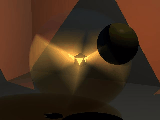 The central ikosaeder sends light out and the beams become
visible in this atom-like simulation.
The effect of "interior light" is easily visible here.
The central ikosaeder sends light out and the beams become
visible in this atom-like simulation.
The effect of "interior light" is easily visible here.

Pure Atmospheric scattering effects:
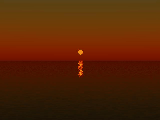 Sunset seen over the ocean on a cloudless day.
Sunset seen over the ocean on a cloudless day.
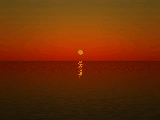 .
Sunset under the same circumstances, but with Mie-scattering.
.
Sunset under the same circumstances, but with Mie-scattering.

Simulation of clouds:
(All calculation times shown are on a 387/33MHz)
In the current simulation stage, clouds are described by four parameters:
Cloud sharpness: determines the off-fall of the cloud's edges.
Cloud complexity: determines the "detailization" of the cloud;
mainly the turbulance parameter of the noise function.
Cloud density: the optical depth of the water vapor the cloud is made of.
Cloud scaling: gives some stretching to the noise function, which would reveil
itself in an unrealistic 'cubical' outlook.
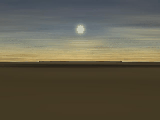 Altocirrus. Sun is 10 degrees above the horizon. (9h51m)
Altocirrus. Sun is 10 degrees above the horizon. (9h51m)
 Smooth cumulus clouds, when the sun is on the same position
as in the preceding simulation.
Please note the shadows of the clouds which are projected on the atmosphere.
Smooth cumulus clouds, when the sun is on the same position
as in the preceding simulation.
Please note the shadows of the clouds which are projected on the atmosphere.
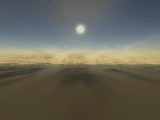 Cumulus clouds, same configuration as before, sun is at 10 degrees,
but now seen from a viewpoint of 1500m above sea level.
The cloud layers range from 2000m-4000m.
Cumulus clouds, same configuration as before, sun is at 10 degrees,
but now seen from a viewpoint of 1500m above sea level.
The cloud layers range from 2000m-4000m.
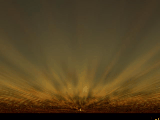 Same cloud configuration as before, but with the sun at one degree
above the horizon. Seen from the ground (3m above sea level).
Same cloud configuration as before, but with the sun at one degree
above the horizon. Seen from the ground (3m above sea level).
 Same cloud configuration as before, but with the sun exactly at the horizon.
Same cloud configuration as before, but with the sun exactly at the horizon.
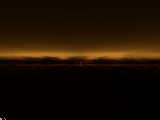 .
The setting sun (one degree above the horizon) is shining through
layers of dense clouds. (1d 1h46m)
.
The setting sun (one degree above the horizon) is shining through
layers of dense clouds. (1d 1h46m)
 Zoom of the preceding image. View angle is 10 degrees. (1d 1h 6m)
Zoom of the preceding image. View angle is 10 degrees. (1d 1h 6m)
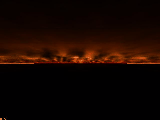 After sunset. The sun is one degree below the horizon. (18h23m)
After sunset. The sun is one degree below the horizon. (18h23m)

Very dense cloud simulation:
Parameters used for the following simulations were:
- Exposure time: 7.5 seconds
- Observer's height above sea level: 1.5m
- View angle: 50 degrees
- Cloud sharpness: 8
- Cloud complexity: 2
- Cloud density: 3E-2
- Cloud scaling: (0.1,1.1)
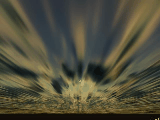 Very dense cloud simulation with sun at 10 degrees above horizon.
Very dense cloud simulation with sun at 10 degrees above horizon.
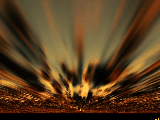 Dense clouds simulation with sun one degree above horizon.
Dense clouds simulation with sun one degree above horizon.
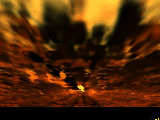 Zoom of the sun setting behind the clouds.
Zoom of the sun setting behind the clouds.
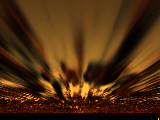 Same weather conditions, with the sun exactly
at the horizon (exposure time is 16 seconds) ,
Same weather conditions, with the sun exactly
at the horizon (exposure time is 16 seconds) ,
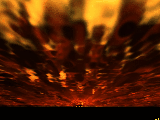 and zoom (10 degrees viewing angle) of the preceding image.
and zoom (10 degrees viewing angle) of the preceding image.
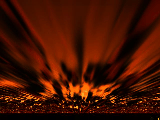 Last not least: The sun one degree below the horizon.
Last not least: The sun one degree below the horizon.
 Just for comparison: A photograph taken on 6.Sept.1995 of a sunset,
which is quite similar to the simulations.
Just for comparison: A photograph taken on 6.Sept.1995 of a sunset,
which is quite similar to the simulations.

More info about cloud simulations:
You may also check out the cloud generation tutorial
which shows the effects of each parameter sequentially.
The images presented here have been created using the
Light++ Raytracing library.
Please have a look at the
online documentation for more
information on functionality and availability.
The cloud algorithm has been described here also.
Copyright notice:
Any of the images shown here are © by Werner Benger.
You may use them for anything you want, under the condition
you give reference to the author.
Please feel free to send any comments to
werner@photon.at
Last modified
 ``Terrestrian Gallery'' also.
``Terrestrian Gallery'' also. ``Terrestrian Gallery'' also.
``Terrestrian Gallery'' also.
 The effect of scattering of light during the transmission of a sphere filled
with tiny particles, which is illuminated from a light source shining from above.
Most raytracing algorithms only take the starting point and the end point of
a light ray during transmission of a nebular medium in effect; they therefore
neglect the shadow effect in the space filled by the medium itself.
The effect of scattering of light during the transmission of a sphere filled
with tiny particles, which is illuminated from a light source shining from above.
Most raytracing algorithms only take the starting point and the end point of
a light ray during transmission of a nebular medium in effect; they therefore
neglect the shadow effect in the space filled by the medium itself.
 The central ikosaeder sends light out and the beams become
visible in this atom-like simulation.
The effect of "interior light" is easily visible here.
The central ikosaeder sends light out and the beams become
visible in this atom-like simulation.
The effect of "interior light" is easily visible here.

 Sunset seen over the ocean on a cloudless day.
Sunset seen over the ocean on a cloudless day.
 .
Sunset under the same circumstances, but with Mie-scattering.
.
Sunset under the same circumstances, but with Mie-scattering.

 Altocirrus. Sun is 10 degrees above the horizon. (9h51m)
Altocirrus. Sun is 10 degrees above the horizon. (9h51m)
 Smooth cumulus clouds, when the sun is on the same position
as in the preceding simulation.
Please note the shadows of the clouds which are projected on the atmosphere.
Smooth cumulus clouds, when the sun is on the same position
as in the preceding simulation.
Please note the shadows of the clouds which are projected on the atmosphere.
 Cumulus clouds, same configuration as before, sun is at 10 degrees,
but now seen from a viewpoint of 1500m above sea level.
The cloud layers range from 2000m-4000m.
Cumulus clouds, same configuration as before, sun is at 10 degrees,
but now seen from a viewpoint of 1500m above sea level.
The cloud layers range from 2000m-4000m.
 Same cloud configuration as before, but with the sun at one degree
above the horizon. Seen from the ground (3m above sea level).
Same cloud configuration as before, but with the sun at one degree
above the horizon. Seen from the ground (3m above sea level).
 Same cloud configuration as before, but with the sun exactly at the horizon.
Same cloud configuration as before, but with the sun exactly at the horizon.
 .
The setting sun (one degree above the horizon) is shining through
layers of dense clouds. (1d 1h46m)
.
The setting sun (one degree above the horizon) is shining through
layers of dense clouds. (1d 1h46m)
 Zoom of the preceding image. View angle is 10 degrees. (1d 1h 6m)
Zoom of the preceding image. View angle is 10 degrees. (1d 1h 6m)
 After sunset. The sun is one degree below the horizon. (18h23m)
After sunset. The sun is one degree below the horizon. (18h23m)

 Very dense cloud simulation with sun at 10 degrees above horizon.
Very dense cloud simulation with sun at 10 degrees above horizon.
 Dense clouds simulation with sun one degree above horizon.
Dense clouds simulation with sun one degree above horizon.
 Zoom of the sun setting behind the clouds.
Zoom of the sun setting behind the clouds.
 Same weather conditions, with the sun exactly
at the horizon (exposure time is 16 seconds) ,
Same weather conditions, with the sun exactly
at the horizon (exposure time is 16 seconds) ,
 and zoom (10 degrees viewing angle) of the preceding image.
and zoom (10 degrees viewing angle) of the preceding image.
 Last not least: The sun one degree below the horizon.
Last not least: The sun one degree below the horizon.
 Just for comparison: A photograph taken on 6.Sept.1995 of a sunset,
which is quite similar to the simulations.
Just for comparison: A photograph taken on 6.Sept.1995 of a sunset,
which is quite similar to the simulations.
